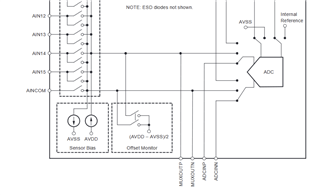Other Parts Discussed in Thread: OPA320, OPA365,
Hi,
In my application I am not using the facility of adding extra signal conditioning between MUXOUT and ADCIN. I would like to know:
1) Should I connect ADCINN and ADCINP to AGND (roughly the midpoint of AVDD and AVSS) ?
2) Could I use them as an extra input to the ADC? Giving me sixteen single-ended inputs and one differential? Fig. 35 of the datasheet would seem to suggest that this is possible.
Thanks, Mark


